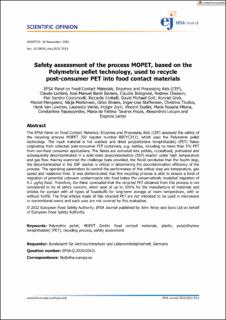Safety assessment of the process MOPET, based on the Polymetrix pellet technology, used to recycle post-consumer PET into food contact materials
Lambré, Claude; Barat Baviera, José Manuel; Bolognesi, Claudia; Chesson, Andrew; Cocconcelli, Pier Sandro; Crebelli, Riccardo; Gott, David Michael; Grob, Konrad; Mengelers, Marcel; Mortensen, Alicja; Rivière, Gilles; Steffensen, Inger-Lise; Tlustos, Christina; Van Loveren, Henk; Vernis, Laurence; Zorn, Holger; Dudler, Vincent; Milana, Maria Rosaria; Papaspyrides, Constantine; Tavares Poças, Maria de Fátima; Lioupis, Alexandros; Lampi, Evgenia
Research report
Published version
Permanent lenke
https://hdl.handle.net/11250/2988462Utgivelsesdato
2022Metadata
Vis full innførselSamlinger
Sammendrag
The EFSA Panel on Food Contact Materials, Enzymes and Processing Aids (CEP) assessed the safety ofthe recycling process MOPET (EU register number RECYC211), which uses the Polymetrix pellettechnology. The input material is hot washed and dried poly(ethylene terephthalate) (PET)flakesoriginating from collected post-consumer PET containers, e.g. bottles, including no more than 5% PETfrom non-food consumer applications. Theflakes are extruded into pellets, crystallised, preheated andsubsequently decontaminated in a solid-state polycondensation (SSP) reactor under high temperatureand gasflow. Having examined the challenge tests provided, the Panel concluded that the fourth step,the decontamination in the SSP reactor, is critical in determining the decontamination efficiency of theprocess. The operating parameters to control the performance of this critical step are temperature, gasspeed and residence time. It was demonstrated that this recycling process is able to ensure a level ofmigration of potential unknown contaminants into food below the conservatively modelled migration of0.1lg/kg food. Therefore, the Panel concluded that the recycled PET obtained from this process is notconsidered to be of safety concern, when used at up to 100% for the manufacture of materials andarticles for contact with all types of foodstuffs for long-term storage at room temperature, with orwithout hotfill. Thefinal articles made of this recycled PET are not intended to be used in microwaveor conventional ovens and such uses are not covered by this evaluation.
